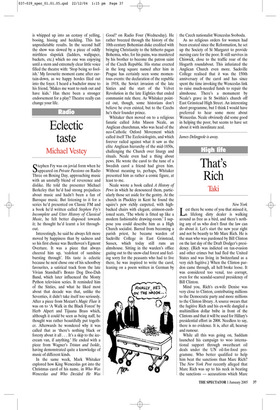Eclectic taste
Michael Vestey
Stephen Fry was on jovial form when he appeared on Private Passions on Radio Three on Boxing Day, approaching music with an unstuffy blend of reverence and dislike. He told the presenter Michael Berkeley that he’d had strong prejudices about music and hadn’t been a fan of Baroque music. But listening to it for a series he’d presented on Classic FM and a book he’d written called Stephen Fry’s Incomplete and Utter History of Classical Music, he felt better disposed towards it; he thought he’d learnt a lot throughout.
Interestingly, he said he always felt more moved by happiness than by sadness and so his first choice was Beethoven’s Egmont Overture. It was a piece that always cheered him up, ‘redolent of sunshine bursting through’. His taste is eclectic because he next chose one of his schoolboy favourites, a satirical track from the late Vivian Stanshall’s Bonzo Dog Doo-Dah Band, which later influenced the Monty Python television series. It reminded him of the Sixties, and what he liked most about that decade was that, unlike the Seventies, it didn’t take itself too seriously. After a piece from Mozart’s Magic Flute it was on to ‘A Walk in the Black Forest’ by Herb Alpert and Tijuana Brass which, although it could be seen as being naff, he thought was rather beautifully put together. Afterwards he wondered why it was called that as ‘there’s nothing black or foresty about it all ... It’s a skip to the icecream van, if anything.’ He ended with a piece from Wagner’s Tristan and Isolde, having demonstrated quite a knowledge of music of different kinds.
In the same week, Mark Whitaker explored how King Wenceslas got into the Christmas carol of his name, in Who Was Wenceslas and Who Decided He Was Good? on Radio Four (Wednesday). He rather breezed through the history of the 10th-century Bohemian duke credited with bringing Christianity to the hitherto pagan Bohemia, who, for his pains, was murdered by his brother to become the patron saint of the Czech Republic. His statue erected in the long square named after him in Prague has certainly seen some momentous events: the declaration of the republic in 1918, the Soviet invasion of the late Sixties and the start of the Velvet Revolution in the late Eighties that ended communist rule there. As Whitaker pointed out, though, some historians don’t believe he even existed, but to the Czechs he’s their founder prince.
Whitaker then moved on to a religious fanatic called John Mason Neale, an Anglican churchman, who was head of the neo-Catholic Oxford Movement which called itself The Ecclesiologists, and which forever railed against what it saw as the elite Anglican hierarchy of the mid-1850s, challenging the Church over liturgy and rituals. Neale even had a thing about pews. He wrote the carol to the tune of a Swedish carol a friend had given him. Without meaning to, perhaps, Whitaker presented him as rather a comic figure, at least to me.
Neale wrote a book called A History of Pews in which he denounced them, particularly those set aside for the gentry. At the church in Pluckley in Kent he found the squire’s pew richly carpeted, with highbacked chairs with elegant, crimson-cushioned seats, ‘The whole is fitted up like a modern fashionable drawing-room.’ I suppose you could describe him as a High Church socialist. Barred from becoming a parish priest, he became warden of Sackville College in East Grinstead, Sussex, which today still runs an almshouse. Sitting in the warden’s office gazing out to the snow-clad forest and feeling sorry for the peasants who had to live there, he was inspired to write the carol, leaning on a poem written in German by the Czech nationalist Wenceslas Svoboda.
As no religious orders for women had been created since the Reformation, he set up the Society of St Margaret to provide nursing care for the poor. It still survives in Chiswick, close to the traffic roar of the Hogarth roundabout. This infuriated the Anglican Church even more. Sackville College realised that it was the 150th anniversary of the carol and has since spent the time invoking the Wenceslas link to raise much-needed funds to repair the almshouse. There’s a monument by Neale’s grave in St Swithin’s church off East Grinstead High Street. An interesting short programme, but I think I would have preferred to hear some more about Wenceslas. Neale obviously did some good in helping the poor, but seems to have set about it with inordinate zeal.







































 Previous page
Previous page